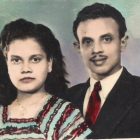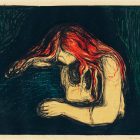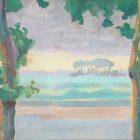On Silence

In the early 2000s, being able to leave Russia for anywhere in the West was considered a significant measure of success for someone like me, a twenty-something graduate of the department of letters of Irkutsk State University in eastern Siberia. My biggest triumph came when I had a chance to start graduate school in America. After I arrived, the prestige of the situation quickly got under my skin; I began stowing away every scrap of thought that occurred to me in America in a Word document entitled Sottisier, or A Commonplace Book. Towards the end of my first year abroad, the file grew into a 25,000-word monument to intellectual omnivory where Aristotle and Wittgenstein were mentioned in the same breath as Saturday Night Live and my first driving experience, and I sent it, along with a few short stories, as a submission for a literary prize in Moscow. It was for authors under twenty-five writing in Russian, and I had submitted my work for it before, to no avail, but my return address was very different now, and I thought it was worth giving it another shot. As it happened, Sottisier was long-listed for the prize in the category “Literary Essay” that year, and one of Moscow’s “thick” literary monthlies decided to publish one of my stories. I had no practical way of collecting the payment that waited for me in the magazine’s editorial office in Moscow, but there was a payment, and the editors said they would be interested in seeing my work again. That was the closest I had ever gotten to realizing my ambition of becoming a professional writer, and I always thought that I had America to thank for it.
That first printed story was about an English exchange student documenting the slow disintegration of his identity amidst the illogical and violent life of a provincial Russian town, and in their pre-publication announcement, the editors hinted that there was a link between my biographical circumstances and the plot of my piece. When it came out and I re-read it in its published form, it also turned out that quite a few convolutions of my purposely disruptive style had been smoothed out without my knowledge and consent. I raised my concerns in a private message to one of the editors; in response, she told me to “keep the hallucinations of your pride in check. It’ll do you good.” I immediately backed down, but from that email exchange with a woman of my age, whom I had never seen and who was in charge of all literature as far as I was concerned, I ran away with the impression that my sense of self as a writer did indeed grow out of aberrations of attitude, big and small.
I had been working on a novel at the time, and when in due course I sent the first chapter to the same editor, she was interested and accepted it for publication, ran it by the rest of the editorial team, sent it back for a rewrite, and finally rejected it. This was my last completed work of Russian fiction, almost a headstone inscription. I tried a few more times after that, with that and other publishers, with poetry and non-fiction, and each time I braced myself for a humiliating “no.” Each time, instead of a “no,” there was silence.
Rejection is always lonely, but at that point, loneliness came with a twist as if it exceeded the expected “normal” levels. If I had, as I believed, done everything right (America, pride), there was something downright cruel about the lack of response, and trying again did not seem to be the right thing to do, any more than doubling down would seem to be the right thing to do after losing your biggest bet. The game seemed rigged, and I had nothing left to double down on. I thought the only way to preserve my dignity, or pride—it no longer mattered—was to become silent and intentionally refuse to shape experience into stories, as if by denying experience any literary purpose the suffering part of the brain exacted some kind of literary revenge on it. This attitude made America seem a lonelier place for me than it probably was.
In the next ten years, I never ceased trying to make sense of what happened, as if my own original understanding had been insufficient and the choice of silence that I had made could only be justified by someone else.
I soon found Susan Sontag’s 1967 essay on the aesthetics of silence in her indispensable collection Styles of Radical Will, in which she argues, quite convincingly, that modern art uses silence to self-estrange. For any artist to whom Sontag, with the unironic literalness of her generation, applied the epithet “serious,” silence is “a zone of meditation, preparation for spiritual ripening, an ordeal that ends in gaining the right to speak.” Silence is meaningful against the background of the artist’s speech, as its tantalizing absence. In other words, art has co-opted silence, including such forms as self-silencing and inarticulacy, as a sort of speech.
Describing ways in which silence literally exists in art, Sontag mentions silence as a decision and silence as a self-punishment on the part of the artist. She goes so far as to call the decision to renounce art “the exemplary suicide of the artist,” without realizing apparently that the all-important difference between the two kinds of self-destruction, literal and literary, is that self-silenced writers sometimes get to speak again. Her list of “model renunciations” by the artist of his vocation opens with a name that has become synonymous with aesthetically motivated self-silencing in Western literature: Arthur Rimbaud (1854-1891), a teenager who at the age of seventeen moved to Paris, started an affair with Paul Verlaine, and became known as one of the most boldly innovative poets in the French language—only to abandon literature and leave Europe at twenty-one.
Another influential book from the same era, Al Alvarez’s The Savage God (1971), approaches actual suicide as a philosophical and literary problem. Alvarez—a survivor of a suicide attempt himself and a friend of Sylvia Plath, the study’s subject—was interested in stripping the idea of a self-destructive artist of its cultural enchantment, Romantic or otherwise, but at the same time spoke resignedly about the “more serious artist” in Modernism whose role in society was to engage in dangerous “psychic exploration” and be “a victim, a scapegoat,” even unto madness and death (echoing, of course, the famous definition of the modern artist as a broker in madness in Sontag’s “The Pornographic Imagination” of 1969, from the same seminal collection, where she asserts that “one of tasks art has assumed is making forays into and taking up positions on frontiers of consciousness, often very dangerous to the artist as a person, and reporting what’s there”). Alvarez also cites the example of Rimbaud and claims that the French poet had even called himself a litteraturicide.
The term litteraturicide, spelled with or without the accent aigu in French and often with two “t”s in English, refers to the practice of self-silencing in literature, as well as to a person engaging in such behavior, and since Rimbaud was the earliest modern instance, it makes sense to ascribe the origin of the word to him. Except Arthur Rimbaud never said anything of the sort.
The word litteraturicide was invented by Rimbaud’s schoolteacher Georges Izambard. In his memoirs, which appeared immediately after Rimbaud’s death in 1891, Izambard reminisced about his young pupil’s letter of May 13, 1871, and called it the “literaturicidal profession of faith of an emancipated schoolboy” (“profession de foi littératuricide d’un rhétoricien émancipé”).
The message contained the first mention of Rimbaud’s famous formula “je est un autre” (“I is another”) and “dérèglement de tous les sens” (“derangement of all the senses”) as a recipe for becoming a poetic voyant, but in fact said nothing about self-silencing. Indeed, Rimbaud would continue writing for another four years. Oddly enough, when Izambard described the letter in his memoirs, he talked about a long text expressive of Rimbaud’s dissatisfaction with his competitors among French poets, past and present. The memoirist may have confused the May 13 letter to him with the May 15 letter from Rimbaud to Paul Demeny, of which Izambard may have heard indirectly: while the May 13 letter was short and did not mention the name of a single poet, the May 15 letter was indeed long and full of truculent criticism of the preceding tradition of French poetry. In any case, Izambard appears to have had difficulty understanding his former student and simply reacted to the sixteen-year-old’s wholesale rejection of literature: litteraturicide in that first instance referred to a disrespectful dismissal of extant forms of artistic expression and had nothing to do with self-silencing.
Twentieth-century literary culture, especially the European movements of the Dadaists and the Surrealists, appropriated Rimbaud for its own purposes. The French authors of that generation both glorified suicide and rejected traditional aesthetics in the name of a new art. When, in 1924, André Breton declared that Rimbaud was a Surrealist in life and elsewhere, he in effect propagated the myth of Rimbaud that erased the distinction between life and art. In another short memoir published in 1928, already catering to an audience used to avant-garde art encroaching on life, Izambard further claimed that when Rimbaud had massacred poets metaphorically in that literaturicidal letter (“litteraturicide où il ne massacrait que les poètes et seulement par métaphore”), he had been prompted by the actual violence of the Paris Commune.
Litteraturicide migrated into the English language and earned a mention in the February 1932 issue of American Speech after the New York Times published, in November 1931, a book review under the headline: “Rimbaud, ‘The Literaturicide’: A Translation of M. Carré’s Brilliant Biography of the Genius Who Deserted Poetry for Action at 19.” The reviewer, William Troy, claimed that “certainly” in Une saison en enfer, Rimbaud “renounces literature along with all the other ‘chimeras’ of Western civilization; he is a declared literaturicide.” I have not been able to find the word “literaturicide” in Jean-Marie Carré’s biography and therefore assume that Troy had taken it directly from Izambard or from another contemporary source, but either way, while doing so, he re-interpreted its meaning in accordance with Carré’s retrospective vision: the poet’s eventual silence now informed the meaning of the poems and letters which had come before and in which Rimbaud had maligned his rivals and predecessors. Rimbaud now renounced all of literature, including his own art; rejection grew into self-rejection, and the poet’s self-silencing became a mystic act for the future public to decipher.
Thus, literaturicide finally came to describe the paradox of literature beyond literature, communication outside any means of communication. This paradox is now part of the myth of Rimbaud, but was it part of his life? The truth is that, despite his declarations in poetry and letters, at the crucial moment, the poet did make a distinction between life and art. Graham Robb’s 2000 biography, Rimbaud, offers what I think is the most plausible explanation for Rimbaud’s mutisme: the poet stopped writing because he had lost hope of being heard. By 1876 he no longer had a companion by his side who could serve as a live audience for his revolt, and most of his distant admirers had not been born yet.
The new century saw the term applied to a practice that the new century had itself inaugurated: self-silencing as a kind of speech. Rimbaud post-mortem started calling himself a name he had never used in life, recognizing, like a true voyant, the radical culture that he did not live to see. Alvarez’s study of literary suicide may have been the first book to popularize the idea of Rimbaud the self-declared literaturicide—the idea Alvarez repeated twice in his text—but in Grigorii Chkhartishvili’s Russian compendium The Writer and Suicide (1996), the word reappears in a section entitled “Encyclopedia of Literaturicide,” in yet another sense of “actual suicide of a writer.” The term described an arc of meaning from provocative to total: a writer consecutively rejected preceding literature, all literature including their own, and life as a condition of literature, all with the sanction of their culture.
*
Rimbaud’s example shows with particular vividness the perverted logic of turning self-silencing into a creative act. It is like saying that death is the prerequisite for getting what you want in life—a confidence trick, where the very culture to which you aspire is handing you a weapon by which you can cease to be its problem. And it is telling that the aestheticization of suicide and the aestheticization of silence in literature took place approximately at the same periods and by the same method: by a radical co-option of life into art, either by the Romantics, the interwar European avant-garde, or the Anglo-American intellectuals of the 1960s. (Something similar could be observed in the tragic attempts at Symbolist “life-creation” among the Russian intelligentsia at the turn of the twentieth century.) This theory seemed alienating and inhuman to me. I did not want to accept it, but without it, I still did not know how to make sense of the silence.
After reading Sontag’s review of The Pilgrim Hawk: A Love Story by Glenway Wescott (1940), who eventually stopped writing fiction, I was prompted to read the novella—and the novelist Michael Cunningham’s introduction to it in the NYRB Classics Book Club edition, where, among other things, Cunningham expressed a belief that “writers who stop writing do so for reasons as ultimately mysterious as those that drove them to attempt writing in the first place.” In the end, he added that readers and writers alike are “sometimes called upon for prodigious acts of patience.” That sounded new and promising. If Sontag did not seem particularly interested in silence as a reaction to unsuccess, as failed and unbegun speech, Cunningham’s formula was closer to my experience. His “prodigious acts of patience” implied an imperative of perseverance in the face of the writer’s current failure to attract the public’s attention. He seemed to understand that sometimes self-imposed silence is not so much about “spiritual ripening” as it is about the extra-literary factors that stand between writer and audience.
This line of reasoning concerning risk factors prompted me to look at books such as Nassim Nicholas Taleb’s 2007 book The Black Swan: The Impact of the Highly Improbable, from which I learned of thousands of patient and talented predecessors appearing and disappearing without a trace just outside of the spotlight of public attention, and which pointed out an unwarranted delusion in the way humans put their trust in randomness. Taleb puts literature in the category of pursuits where there is a severe concentration of success, with “a very small number of winners claiming a large share of the pot” while the exact distribution of it depends on a momentous random event, the eponymous Black Swan. In chapter seven of the book, he summarizes the dilemmas of those who dare to seek recognition in such areas. Among other things, he named the cruelty of bystanders who judge a random triumph by the standards of routine rewards and, in parallel to it, the consequences of postponing gratification indefinitely while betting big on the appearance of a Black Swan. To illustrate his point, he described a stock trader named Nero whose strategy had a small chance of success, but the success was large enough to justify, and recover from, continual losses over a long period of time. This strategy, Taleb pointed out, required “a combination of belief, a capacity for delayed gratification, and the willingness to be spat upon by clients without blinking.” The chapter is fittingly entitled “Living in the Antechamber of Hope.”
The knowledge that there are occupations where the uncertainty of outcome often exceeds the limit of what a human mind can endure without some neurological and emotional damage—and that literature is one of them—came as long-awaited relief. That damage no longer had to be self-inflicted. Suddenly, I grew up intellectually. Being cut down to size made better sense than persisting in adolescent Dostoevskian pride, and I did not have to be so unforgiving as to sabotage myself when dealing with the unbearably, punishingly inscrutable fate. I learned to differentiate between what was and what was not in my control.
This learning also coincided in time with two events of tremendous significance in my life. One was that my writerly exile in America, to which I sacrificed every other writerly activity, including writing, turned out to be far from certain. I had finished grad school by then and was teaching Russian as a visitor at a Midwestern university, but my time there was coming to an end, and the twenty-four job applications I had submitted to various institutions in the U.S. that year had led to no offers. Without a job contract, I was about to become an illegal alien, obligated to leave the country in which I had lived for more than a decade and that I considered my home. I started packing and was agonizing over what to do with my cat. When, three weeks before the expiration of my contract, a job offer came, that success, albeit less random than literary success, was nevertheless serendipitous enough to show me the extent to which luck determined my place in life. At that point, I already knew how to be grateful when fate was kind.
The other event concerned my Russian circumstances, which underwent one last change before they became irreversible. My father died in July of that year. He died a mere two months after being diagnosed with stage-four cancer, in an Irkutsk hospital, in far-away Siberia, where the rest of my family lived. My mother and brother were with him in the hospital at first, but even they were not allowed to comfort him at the end, due to the visiting policies in Russian ICUs. There was an unquenchable sense of injustice, a tragic sense of calamity about his untimely death, and I struggled with it, eventually letting it deepen my abstract awareness of fate into a sense of quiet urgency.
In the months that followed after his death, I finished a book-length manuscript of commemorative prose, which grew out of a Facebook post about my father and my last conversations with him. That was my lesson in grieving. I wrote in English, a language my father could not understand, probably because its strangeness could capture the trauma while at the same time protecting me from it.
Neither the privilege of having an American address, nor the performative quasi-suicide of self-silencing had saved me from the risk of irrelevance: it was emphatically the work of articulating, and holding on to, what I really loved that helped me endure uncertainty and failure and eventually return to writing. Writing started to happen precisely in response to a heightened sense of fragility in what I held most dear: my family in Russia, America, and literature. The experience of silence I am trying to describe was not the same as the experience of twentieth-century gay authors like Wescott, or E. M. Forster whose Maurice had to wait almost sixty years to be published, or the experience of women writers, or and especially the experience of writers of color. Aestheticized self-silencing is often an expression of privilege, and the uncomfortable truth is that I had not realized that until I was about to lose my privilege and until someone I knew very well had been silenced for good.
In what was perhaps the greatest lesson I learned, empathy towards Rimbaud, Wescott, and Forster allowed me to identify my own more deep-seated reasons for wanting to stay in America and for wanting or not wanting to speak. My truth was that I had felt alienated from the male gender to which I was assigned at birth for as long as I could remember—without being able to articulate that to anyone, including myself. There had been no such words as “trans” or “genderqueer.” It was something I had never said to my father, something I still cannot say freely at home, and the silence of the closet has been more ancient, more violent, more deafening than my literary self-silencing, though not unrelated to it. Both self-silencing and being in denial with regards to my gender were, in my case, attempts to relativize the reality of painful experience to the point where it no longer seemed real. The dragon was as good as slain if it was never challenged to battle. Silence was not silence if I pretended that it concealed nothing but prescribed meaning.
This approach struck me as remarkably similar to the aestheticization of silence, in which all reasons for non-speaking were proclaimed as having literary significance. In both instances, the goal was to deny the existence of extra-literary risk factors, to resist reality, to avoid pain, and in both instances, the habit of overlooking one’s own pain made it too easy to overlook the pain of others. I often wonder if Sontag’s overly fervent embrace of the aesthetics of silence had something to do with her staunch life-long refusal to come out and openly admit she was bisexual. Benjamin Moser in a recent biography of Sontag (2019) approaches this point from a different direction: when in 1986 (almost twenty years after “The Aesthetics of Silence”) Sontag refused to acknowledge publicly that the mysterious disease slowly killing a young man in her short story “The Way We Live Now” was AIDS, she placed herself outside contemporary AIDS activism whose critique of silence, that is, critique of the closet (“Silence = Death”) proved to be its most enduring legacy.
I am still discovering ways in which my identity relates to my writing, but, in one particular way, it gives it relevance. When voicedness in art is tied to vulnerability in life, exposure—and not evasion, denial, and declarative muteness—ensures survival.
This post was originally published on October 21, 2020.



